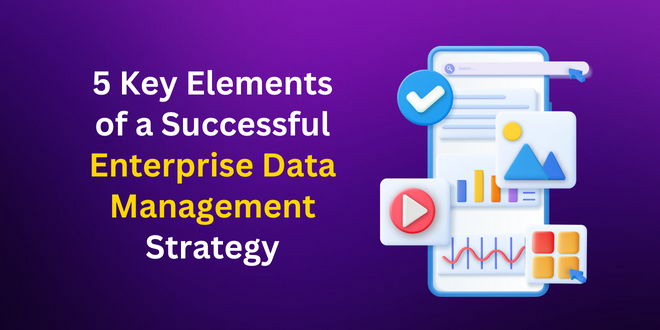Introduction
Data is at the center of every business and irrespective of the size of the company. Data help fuel the decision-making process. It is now time to discuss the actual process of developing your EDM solutions or strategy. Keep in mind that the following enterprise data management steps will vary depending on where you are in your data management journey and the technology stack you already have. Some steps may need to be completed concurrently or in a slightly different order.
- Assess Current Situation
- Define Needs and Objectives
- Identify the Needed Tools
- Evaluate Options
- Implement and Monitor
The first step in the enterprise data management process is assessing current situation. This will help you get a better understanding of your company’s existing data practices and capabilities. With the help of EDM solutions, you will be able to identify where improvement can take place.
The next step of the enterprise data management is defining needs and objectives. After performing this enterprise data management assessment, you will be able to determine what kind of software or hardware is needed to achieve your set out goals and objectives. Once you’re clear on what tools are required, it’s time to determine the final needs that are required for implementation.
Once you have identified all the required enterprise data management tools and hardware, it’s time to think over how they should be used in order to achieve your set out objectives. This will help keep the project on track and also allow you to quickly identify if things are working as intended or not.
Employ EDM solutions and tools
You can put the enterprise data management tools at use – the one that you identified in the previous step to use and begin reaping the benefits. If you’ve gone the custom route, your team will now concentrate on the solution’s UI/UX design, backend and frontend development, and testing.
- Establish an effective data governance structure: An effective data governance structure should be established to ensure data accuracy, integrity and compliance. The structure should include roles and responsibilities for data stewards and data owners, clearly define data policies and processes, and ensure that data is managed according to best practices.
- Define a data architecture : A well-defined data architecture serves as the blueprint for the data management strategy. It should include an architecture for collecting, storing, analyzing, and sharing data across the enterprise.
- Implement data security : Data security should be a priority when implementing a data management strategy. Security measures should include authentication, authorization, encryption, and access control.
- Develop data quality standards: Data quality is essential for successful data management and analytics. Establishing data quality standards, such as defining and standardizing data formats, can help improve the accuracy and reliability of data.
- Invest in data management tools : Investing in the right data management tools can streamline data management processes and ensure the accuracy and integrity of data. Examples of data management tools include data warehouses, data lakes, and data visualization tools.
Develop Policies for Data Governance
You can begin establishing your data governance policies by implement them in the core enterprise data management stack once everything is in place, or even while the necessary solutions are being implemented. This critical component of an enterprise data management strategy has already been mentioned, but it bears repeating.
Determine the standards, policies, and procedures that must be followed by the entire organization in order to prevent security breaches, data corruption, and loss. Furthermore, remember to account for regulatory compliance and include any necessary guidelines in your documentation when integrating EDM solutions. This is especially important in highly regulated industries such as finance and healthcare.
About Yodaplus
Yodaplus is a USA-based company that offers bespoke enterprise data management solutions as well as prompt implementation of packaged solution with an industry standard data model and efficient workflow. Experts at Yodaplus work with clients from USA to transform raw data sourced from their internal and external systems into quality-checked, accessible, actionable insights that are ready to be used by systems and users.
Data dissemination, greater transparency, data governance, data quality measurement, data quality and seamless integration are some the benefits of Yodaplus’s USA-based enterprise data management services. Yodaplus’s USA-based EDM solutions enable Finanancial firms to hit KPI metrics and accurately make key decisions that determines the profitability of the firm.











